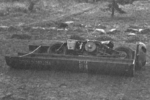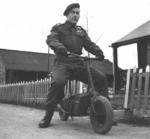Welbike
| Country | United Kingdom |
| Manufacturer | Excelsior Motor Company, Birmingham, England, United Kingdom |
| Primary Role | Motorcycle |
Contributor: Alan Chanter
ww2dbaseThe Excelsior Welbike was a wartime attempt to improve the mobility of airborne forces by providing them with a motorcycle that could be parachuted in a container or landed by glider. Therefore the machine needed to be small, lightweight, cheap and expendable. The task, which was inspired by the German's use of air-portable motorcycles in the Crete campaign in Greece, was placed in the hands of the government's military research centre in Welwyn in Hertfordshire, England, United Kingdom (hence the name of Wel-bike) whose designer, Lieutenant Colonel John Dolphin, began with a standard airborne equipment container and then sketched out a miniature motorcycle with foldable handlebars and saddle to fit inside.
ww2dbaseThe design was then passed to the Excelsior Motor Company of Birmingham, England to build a prototype. Excelsior was a long established engineering company who lay claim to have been the first British maker of motorcycles for sale to the general public, but had never been a major manufacturer. In fact, at the beginning of the war their factory was only undertaking contract engineering work rather than producing motorcycles.
ww2dbaseThe resultant prototype was a crude, but tough and effective machine powered by a 98cc two-stroke Villiers autocycle engine through a single speed gearbox. Ignition was by flywheel magneto. As the dimensions of the container were very restricted the size of the bike was necessarily small. The frame was of twin loop tubular construction with folding handlebar and telescopic seat tube. It had no suspension or lights and only one brake (essentially the barest minimum necessary to keep down weight). The tiny 6.5-pint fuel tank had to be pressurised by pump, before it went into action, as it was located too low to supply petrol by gravity feed. To prepare the Welbike for use, the handlebars simply had to be swung up and outwards until they locked on spring loaded pins. Then the saddle pillar was pulled up and the footrests pushed down until they too locked in place.
ww2dbaseExcelsior was contracted to build the machine, and after some refinements (such as substituting rubber handlebar grips with ones made of brass and canvas) it went into production with Excelsior's own 98cc autocycle engine. As planned, the Welbike could be made very cheaply and quickly - so quickly that the frame, engine and all were painted in one go whilst still on the production line.
ww2dbaseAlmost 4,000 were built from 1942 until the end of the war and saw action in parachute drops as well as during beach assaults. The Welbike's use was, however, limited by its low performance especially over rough terrain where the 10-inch wheels quickly clogged up with mud. In the heat of battle, even the few seconds needed to remove it from its container and unfold it could be a drawback. The riding position was not very comfortable for a man of more than average height and no equipment could be carried at all. Indeed one man overloaded it. In addition it was quickly discovered that the small wheels made the bike virtually useless away from a made-up road, and the additional mobility was not enough to warrant the manufacturing effort. Consequently many Welbike's saw more use as airfield transport than on the front line.
ww2dbaseThe Americans were rather more successful in producing an air-portable motorcycle. After trials with the somewhat heavy Simplex motorised bicycle, in 1944 they adopted the Cushman airborne motor-scooter for issue to parachute units, and although this was more purposeful than the British Welbike, at 499-pound weight it was actually some 150 pounds heavier than standard British Army's 350cc BSA. It was joined later by the conventional Indian M1 Extra light Motorcycle which at 241 lb was indeed "extra light" by American standards.
ww2dbaseAfter the war some Welbikes were sold off – although without fitting a front brake, they could not legally be used on British roads. Meanwhile the original designer had been developing a civilian version, which he showed to the general engineering concern Brockhouse Engineering soon after the war. Brockhouse built the model in small numbers and sold it as the Corgi, using the single-speed Excelsior engine. The Corgi proved to be too slow and too unrefined even for a transport–hungry post-war economy, and manufacture was soon discontinued (although the concept returned in a much more sophisticated form with the folding Honda "Monkey Bikes" of the 1960s ad 70s).
ww2dbaseExcelsior, for a while continued production of their own autocycle and later built a popular 250cc two-stroke twin - the Talisman. Excelsior last manufactured motorcycles in 1964 and folded a year later. The factory then went over to the production of accessories for Britax, a car accessory company, who bought the name and produced limited numbers of Britax-Excelsior machines during the late 1970s bought the name and produced limited numbers of Britax-Excelsior machines during the late 1970s.
ww2dbaseSources:
Andrew Kemp and Mirco De Cet, Classic British Bikes (Colour Library Direct, 1997)
Ian V Hogg & John Weeks, The Illustrated Encyclopedia of Military Vehicles (Hamlyn 1980)
John Reed, Motorcycles in WWII (Article in War Monthly, October 1981)
Wikipedia
Last Major Revision: Oct 2012
SPECIFICATIONS
Welbike
| Machinery | One 1-cyl 98cc air-cooled Petroil lubricated 2-stroke engine with single speed gearbox |
| Suspension | Chain drive to rear wheel |
| Crew | 1 |
| Length | 1.34 m |
| Width | 0.56 m |
| Height | 0.38 m |
| Speed | 48 km/h |
| Range | 145 km |
Photographs
 |  |  |
Did you enjoy this article or find this article helpful? If so, please consider supporting us on Patreon. Even $1 per month will go a long way! Thank you. Share this article with your friends: Stay updated with WW2DB: |
Visitor Submitted Comments
27 Jul 2015 08:50:46 PM
Hello ,Am from Southern part of India
am having one original excelsior welbike.
the engine no is XXE 3099 AND Frame no 294/23 S1946.
am also in the process of restoring the civilian version of the bike COORGI SCOOTER. Am looking for both wheels.
1 Apr 2016 01:53:50 AM
Hi I have a welbike motor (Villiers) for sale. The motor is complete and good condition but I have not tried to start it. Can you tell me aprox what is it worth. I am in Australia.
8 Apr 2016 04:30:08 PM
Hi Malcolm where can I reach you regarding the welbike ?
11 Dec 2016 10:13:37 AM
I have a 1942 Welbike #800 for sale
All visitor submitted comments are opinions of those making the submissions and do not reflect views of WW2DB.
- » Wreck of USS Edsall Found (14 Nov 2024)
- » Autumn 2024 Fundraiser (7 Nov 2024)
- » Nobel Peace Prize for the Atomic Bomb Survivors Organization (11 Oct 2024)
- » Wreck of USS Stewart/DD-224 Found (2 Oct 2024)
- » See all news
- » 1,150 biographies
- » 337 events
- » 43,917 timeline entries
- » 1,241 ships
- » 350 aircraft models
- » 207 vehicle models
- » 373 weapon models
- » 123 historical documents
- » 260 facilities
- » 470 book reviews
- » 28,536 photos
- » 432 maps
Winston Churchill, 1935
Please consider supporting us on Patreon. Even $1 a month will go a long way. Thank you!
Or, please support us by purchasing some WW2DB merchandise at TeeSpring, Thank you!
29 Oct 2012 06:08:13 PM
If anyone has info on parts for a Brockhouse Corgi
PLEASE E-Mail me THANK YOU TIM ant the Welbike artical was GREAT THANKS AGAIN